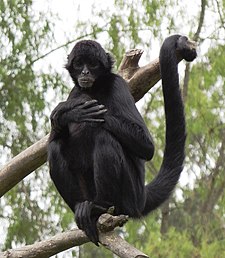New World monkeys are the families of primates which are found in Central and South America. The families are ranked together as the Ceboidea superfamily, the only living platyrrhine superfamily. They differ from the Old World monkeys and apes, which are Catarrhini.
- Platyrrhini: the New World monkeys.[1]
Superfamily Ceboidea- Family Cebidae: capuchins and squirrel monkeys.
Subfamily Callitrichinae: marmosets and tamarins.
Subfamily Aotinae: night or owl monkeys - Family Pitheciidae: titis, sakis and uakaris
- Family Atelidae: howler, spider, muriqui (woolly spider) and woolly monkeys
- Family Cebidae: capuchins and squirrel monkeys.
| New World monkeys | |
|---|---|

| |
| Black-headed spider monkey | |
| Scientific classification | |
| Kingdom: | |
| Class: | |
| Order: | |
| Suborder: | |
| Infraorder: | |
| Parvorder: | Platyrrhini Geoffroy, 1812
|
| Superfamily: | Ceboidea
|

| |
| Range of New World monkeys | |
Origin
changeAbout 40 million years ago, the simians separated into the groups: the Platyrrhini (New World monkeys) and Catarrhini (apes and Old World monkeys).[2] The key question is how did the early monkeys get to the Americas? There is no evidence for either of the two possible routes. Route one is across the then less wide Atlantic. Route two is across Asia, across the Bering Strait, and down through North America.[3]
There are some big differences between the two groups of monkeys. New World monkeys have flatter noses with nostrils facing to the side. Most do not have full colour vision,[4] they have a different dental formula, many form monogamous pair bonds, with paternal care for the young, mostly, twin births are common,[5] and their thumbs are not opposable. The Atelidae family have long tails that can grip to things.
Related pages
changeReferences
change- ↑ Schneider, Horacio 2000. The current status of the New world monkey phylogeny. Anals de Academia Brasileira de Ciéncias 72, 2, [1]
- ↑ Robert W. Shumaker & Benjamin B. Beck (2003). Primates in question. Smithsonian Institution Press. ISBN 1-58834-176-3.
- ↑ Alan de Queiroz, The Monkey's Voyage, Basic Books, 2014.
- ↑ Jacobs G.H. et al 1996. Trichromatic colour vision in New World monkeys. Nature 382 (6587): 156–158. [2]
- ↑ "New World Monkeys". Archived from the original on 2005-12-11. Retrieved 2015-04-08.